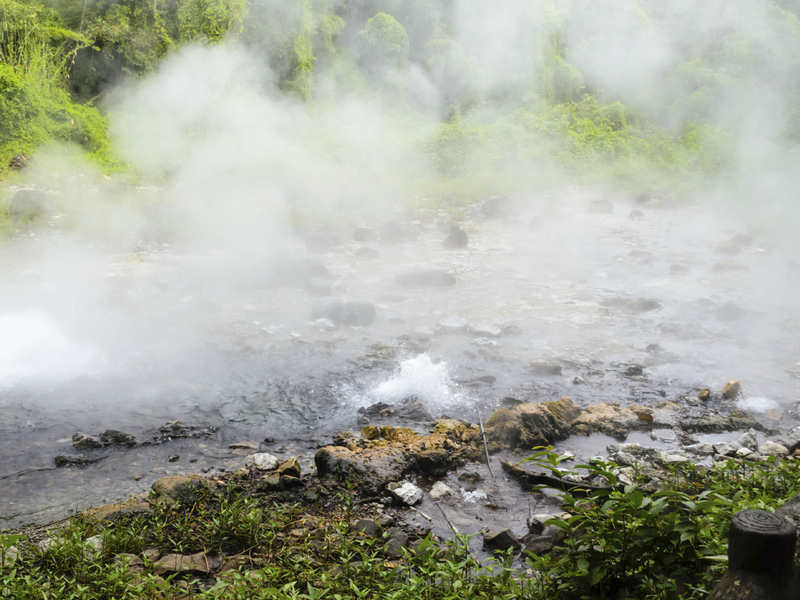Water Molecules Need Help to Evaporate
For a water molecule to evaporate—transition from liquid to gas—it takes a rare sequence of events involving assistance from two other molecules, according to new computer simulations. Researchers watched 500 virtual liquid water molecules and found that one could only escape the liquid phase if impacted at a precise moment by a bound pair of molecules within the liquid. An improved understanding of evaporation could help researchers modeling atmospheric processes that are part of climate change.
Heat, by making molecules move more violently within a liquid, can break the hydrogen bonds that normally hold water molecules together, releasing individual molecules to the air. Previous work has established that molecular ejection requires a collective process—the coordinated interaction of three or more molecules, rather than simple collisions between two.
Yet little is known about these collective mechanisms. In principle, the crucial interactions could happen in many ways. But Yuki Nagata and colleagues from the Max Planck Institute for Polymer Research in Mainz, Germany, have now shown that such events always involve a common element—a particular, well-timed, three-body interaction that seems crucial to delivering enough energy into one molecule to allow it to escape.
The team ran computer simulations of 500 water molecules held in a tiny volume. They set up a liquid region—a zone of relatively high density, with molecules close together and many linked strongly by hydrogen bonds. Adjoining the liquid was a zone empty of molecules. When they chose a temperature high enough to drive evaporation, the researchers saw, as expected, occasional evaporation events. Random jostling would send a molecule out of the liquid zone and into the empty zone. In their simulations, the team recorded 325 such events.
To learn how these molecules gained enough energy to overcome the strong hydrogen bonding tying them to other molecules in the liquid—each molecule is typically involved in three or four such bonds—Nagata and colleagues inspected the molecules’ trajectories. They found that an ejected molecule always gained its energy through a precise interaction with two other molecules. It always had a violent collision with a fast-moving molecule just prior to leaving the liquid. This fast-moving molecule, further study showed, was hydrogen bonded to a third molecule in a way that was crucial to the evaporation process.
Two hydrogen bonded molecules continually oscillate, moving closer and further apart rapidly, with a characteristic frequency. The researchers found that a molecule that would be ejected always collided with the bonded pair at approximately 40 femtoseconds after the pair reached their closest approach. The moment of collision was also the moment when the bound molecules would be moving apart at maximum speed and able to deliver the most energy. The pair as a whole need not be moving rapidly; instead, the kinetic energy from the oscillation could deliver most of the energy needed to eject the original molecule from the liquid.
The implications, Nagata and colleagues argue, are two-fold. First, it seems that evaporating molecules always get kicked out of the liquid through a common mechanism. Second, the success of any molecule in escaping requires the interaction of three molecules, not just two. Even though one member of the bound pair of molecules never collides with the ejected one, the bond it forms with the impacting molecule makes all the difference. “Evaporation always involves a coordinated, well-timed motion of several water molecules,” says Nagata.
These results, other researchers suggest, put the evaporation process in a new light. According to theoretical chemist Adam Willard of the Massachusetts Institute of Technology, previous simulation studies have mostly examined the bulk thermodynamics of water evaporation, treating water as a continuum, and neglecting effects tied to individual molecules. “This paper really dives into the molecular details,” says Willard, “and has managed to tease out a rather surprising result.” Moreover, the team didn't need superior computational tools. “There is no special technique at play here,” he says, “just good physical intuition, and a well executed piece of statistical analysis.”
This improved understanding of water evaporation may find applications in technologies for reducing unwanted evaporation, the researchers suggest, for example, in stores of purified water. It might also be helpful to geophysicists studying the influence of atmospheric aerosols on cloud formation through evaporation, a process of importance for climate change.
This research is published in Physical Review Letters.
–Mark Buchanan
Mark Buchanan is a freelance science writer who splits his time between Abergavenny, UK, and Notre Dame de Courson, France.





